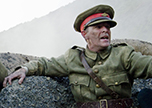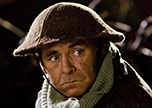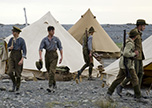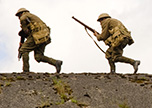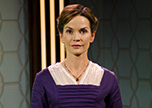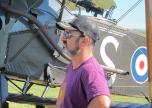« War News
Behind the Scenes
Description
Behind the scenes with Nick Riera, Chris Tyson and Mike Smith
Avalon Studio 9 has been transformed into a traditional news set but there’s something curiously different about it.
Instead of high gloss surfaces with a bank of television screens, or a wall that gives a view into a busy newsroom, this studio has a vintage feel, with muted colours, wallpaper and leadlight details.
Actor Mark Mitchinson is in the host’s seat, running his lines as Ray Harkness, the dapper anchor of War News, the Gibson Group series that puts a TV current affairs team in the midst of WWI.
Mitchinson looks like something out of Downton Abbey. His script is complex - he's about to mediate a fiery debate between Māori leaders Maui Pomare and Te Puea Herangi. The two actors playing the historic figures make their way into the studio and director Mike Smith calls action.
Crafting a television news studio to look as if it could exist in 1914 was one of the main challenges for production designer Nick Riera (Fresh Meat, Aftershock, Paradise Café, King Kong, The Water Horse).
“I was very excited about the concept. The brief for me was ‘1914 Modern’, which is quite a tricky concept to get your head around. So I did a lot of research into Charles Rennie Mackintosh and the 1914 Arts and Crafts through to 1928 Art Deco.
“We are bombarded with information about World War Two and Vietnam, but nobody really knows that much about World War One, and it’s unbelievable what we found out about what these guys had been through. Being able to put across that information to people is pretty special.”
Recreating the battlefields of Europe on a tight budget in unpredictable weather was another big challenge in filming War News. Fortunately, Wellington provided locations that bore remarkable similarities to the actual sites. The Wainuiomata coast substituted for the Sinai Desert and Palestine, Red Rocks stood in for Gallipoli, Queen Elizabeth Park on the Kapiti Coast was the Somme, and a field next to Avalon Studios was dug up to create the muddy quagmire of Passchendaele, the site of the blackest day in New Zealand’s military history.
“I tried to make everything as nasty as possible” says Riera.

“And you succeeded!” says producer Chris Tyson. “We couldn’t find an existing location for Passchendaele, so we ended up doing it in the Avalon back lot. We dug it up and put the rain towers in it. When you see it on the screen you can feel the misery. Because they were miserable. We had extras running around in the mud in the middle of the night and it was cold.
“That’s part of the reason we did it at Avalon. We could use their showers and actors green rooms to keep people warm. A lot of effort went into keeping people warm.” The filming on each night ran through until about 2am.
Sometimes there were unexpected concerns on set. The Sinai Peninsula set on the Wainuiomata coast featured old-fashioned bell tents, horses, the works. But, after waiting for the weather to come right, “we then had to dance around the endangered dotterels. There were four nests and two of them were in the area we wanted to shoot, right in the middle of where we wanted to put the camera,” says Riera.
For director Mike Smith, another challenge was creating a sense of the scale of war. “Because it’s a docu-drama essentially, there’s not a lot of money, so we’ve had to think of clever ways to show war. What we did is what they do on big films, a technique called ‘tiling’, where you lock the frame off and add the numbers up: soldiers in the front of frame, then the middle of frame and so on.”
Technical and budgetary concerns aside, filming War News was emotional for the cast and crew. “Those poor bastards,” says Riera. “It was an insane loss of life. And then the staggering figures like the Germans firing 1.6 million artillery shells in 5 hours...“
“... how in sanity could you put up with that noise?” Tyson agrees. “It was a disgusting war.
“We killed off a generation of young men. On both sides.”




